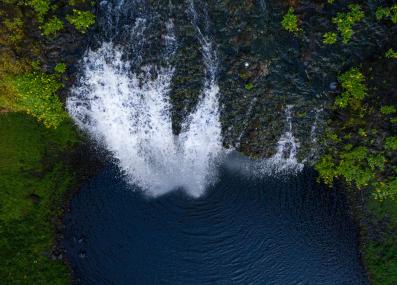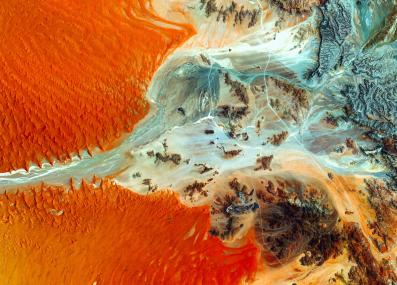Have a question?
Can we cool the Earth by covering more of it with snow?
More snow cover could reflect more sunlight back into space. But tinkering with the climate is not something to be taken lightly.
May 17, 2022
If you’ve ever been sunburned on a ski trip, then you’ve experienced firsthand snow’s talent for reflecting sunlight. Snow and ice are so good at reflecting light, in fact, that they play an important role in regulating the Earth’s climate by bouncing some of the sun’s rays back out into space. The loss of snow and ice cover caused by climate change is a troubling trend because it reduces the planet’s ability to reflect sunlight.
But what if humanity tried to turn the tide of snow cover? After all, ski resorts cover their slopes in fake snow when Mother Nature doesn’t provide enough of the white stuff. So, perhaps, countries could decide to cover more of the Earth’s surface in artificial snow, reflecting more light back into space, thereby cooling the planet.
Visiting climatologist at MIT Judah Cohen says the idea has promise—in theory. But in practice, creating enough snow to cool the planet may be impossible. And like other kinds of geoengineering (which is a term for altering the climate via large-scale engineering projects), it could spark a series of unintended consequences for our weather and climate.
Why does the idea have promise? In short, because snow is really good at reflecting sunlight. Scientists use the term albedo to refer to the percentage of light a given material reflects. The Earth has an average albedo of about 0.3, meaning it reflects 30 percent of the sun’s light.1 The ocean’s albedo is very low because water (which covers about two-thirds of our planet) is so good at absorbing solar energy. But ice is good at reflecting sunlight, and snow is even better—it reflects about 80 percent of sunlight, Cohen says, the highest naturally occurring albedo. Plus, snow is especially good at emitting longwave radiation back to space, especially on clear nights when no clouds are in the way.2 This cools the surface even more.
Given these cooling effects, it could make sense to want more of the planet to be snow-covered to combat rising global temperatures. But here’s the first problem Cohen points out: Where would you put it? To get the most bang for your buck, you’d need to put a lot of snow in a sunny place so it could reflect a lot of light. But it can’t be somewhere too warm, either. “If you covered Florida in snow, it’s not going to have much impact because it’ll be gone before you do anything,” he says. Only a few parts of the world, such as Siberia and the Tibetan Plateau, qualify as good candidates, because they are large areas that are cold enough to maintain snow cover, sunny enough for the snow to reflect a lot of light, and have seen diminishing natural snow cover because of climate change.
Then there is the problem of producing so much artificial snow, enough to cover thousands upon thousands of square miles. And just like a ski resort, this geoengineering endeavor would need to pile up snow at such a depth that the ground would not be exposed if some of the snow melts. “For this to be something that has an impact on a global scale, you’re talking about huge amounts of water, impractical amounts of water,” Cohen says. A world in which freshwater scarcity is a worsening problem probably can’t afford this, he says.
Another issue is that making a lot of fake snow also requires a lot of energy—and if that energy comes from fossil fuels, then it contributes to the very problem that the snow was intended to solve. A 2011 study of Swedish ski resorts found that even a newer, more efficient approach to snowmaking required around 1 kilowatt hour of electricity to make a cubic meter of snow.3 (Covering Beijing in fake snow for the 2022 Winter Olympics reportedly required 1.5 kWh per cubic meter.4) To cover just one square mile of terrain with snow one meter deep, you’d need more than 2,500,000 cubic meters of snow, and thus, 2.5 gigawatt hours. According to the Department of Energy, the whole United States has about 97 gigawatts of solar energy capacity.5 This means that covering a whole region in snow would require a significant chunk of a country’s low-carbon energy—energy it needs for many other uses.
But even more concerning is the idea of tinkering with the delicate, interconnected systems that govern the climate. Geoengineering schemes, whether adding fake snow cover or seeding the atmosphere to create more clouds, can set off a domino effect of unplanned and surprising consequences. In the case of adding snow cover, Cohen says, one could alter the circulation of the atmosphere above the newly introduced-snow. In his research, he has argued that additional snow covering Siberia could disrupt the polar vortex, a persistent weather pattern over the North Pole, setting off a cascade of wide-reaching effects including a drier Western United States—a region already afflicted by drought.
Albedo is powerful. If people could summon the political will, the freshwater supplies, and the required clean energy to cover a huge swath of the planet in snow, then yes—this could, in theory, be enough to help cool the Earth, Cohen says. But the challenges and unknown consequences of doing so make it a difficult solution to argue for.
“There’s no free lunch here,” he says.
Thank you to Deborah of Alexandria, Virginia, for the question. You can submit your own question to Ask MIT Climate here.
1 NASA Earth Observatory: Measuring Earth's Albedo. Accessed May 17, 2022.
2 Weather 5280: Fresh Snow Cover and Clear Skies: Why So Cold at Night? By Noah Brauer, January 10, 2017. Accessed May 17, 2022.
3 Energi & Kylanalys. "Energy usage for snowmaking." April 2011. Accessed May 17, 2022.
4 "We couldn’t have the Beijing Olympics without snow machines. How do they work, and what’s the environmental cost?" By Chiara Neto and Isaac Gresham, The Conversation, February 13, 2022. Accessed May 17, 2022.
5 U.S. Department of Energy: Solar Energy in the United States. Accessed May 17, 2022.








